This drawing depicts a second cousin of mine, Eva, and her mother Klara, my mother's cousin, both of whom and their family I wrote about previously here and showed photographed. Klara added the two names, diminutive ones in Hungarian, and I drew this in Kremnica, her and my mother's Slovak hometown I wrote about, which my two models visited from their home in Budapest. Klara sent me this drawing to the U.S. (she died since), and I was, immodestly, surprised by some things in it. A three-quarter foreshortened view of a face isn't easy to draw, and I also had some understanding of subtle shading, as under the jaws. I also did some caricaturing in the head of my little cousin.

Likewise little Eva, when she was 9 and I 12. Done a year after the preceding, again on vacations in Kremnica, I was already an "accomplished" portraitist, as may be seen by the swiftness of the strokes. I may be terribly conceited, but I haven't found anyone else in history who could draw like this at this age.

Another portrait of Eva, in 1942 in Budapest. To explain why all the same subjects: Her family, as I wrote elsewhere here, was the only whole one of my European relatives to survive the Nazis, and so also retained some of my artwork. Her brother, an amateur photographer, years after sent me then the photos of their portraits on this page (except the first, dual, one).
I drew this picture when my mother and I visited them from Gyöngyös, then our hometown I likewise wrote about. Our visit, in the big city of Budapest, impressed me deeply. I did the drawing in the evening under artificial light, and depicted my mood with the deep cast shadows. It is my Mona Lisa in a way.
But I want to relate a story regarding that renowned painting. I am sure it was at the same visit that I asked Eva's mother why Mona Lisa is so famous. My reason was a misgiving although I didn't say so. I felt that Mona Lisa's forearms were poorly foreshortened and her hands awkward. I still accepted the authorities, but now don't share the opinion that it is a great work of art.
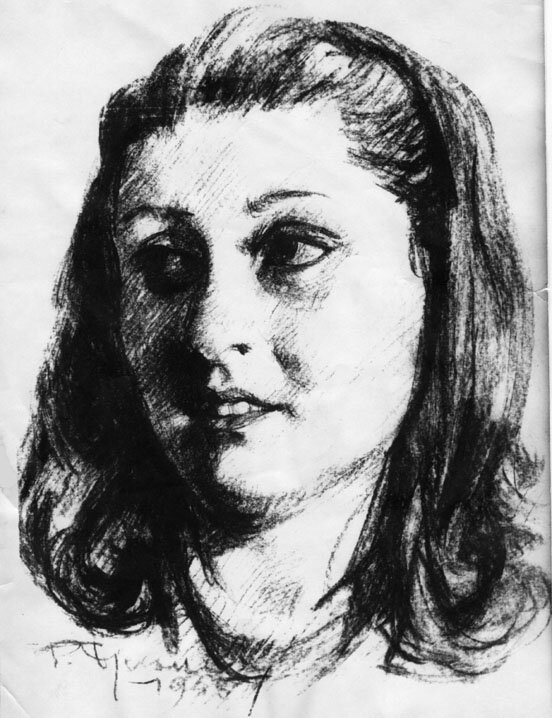
As again recounted in other parts of this website, after my wartime survival I stayed, in 1945, with that family for a few months and of course kept my pencils or brushes busy. This picture, of Eva once more, is actually done with charcoal, I believe. It regardless may have lost some middle tones when photographed.
1 August 2012. This is Zsuzsu, the niece of preceding Eva, and whom I mentioned with the following picture. She was eleven at the time of this drawing. It was made with crayons she used in school, but I don't know what kind they were.
12 September 2012. Like the preceding drawing, this and the next drawing were inserted late, without changing the other items, including the text. These two added portraits are then of preceding Zsuzsu's father, son of Klara below. As I mentioned elsewhere on this website, he was liberated from Gunskirchen concentration camp at the same time as my father, brother and I. He was almost the same age as I.
This is a pencil drawing, in which I didn't seem to pay much attention to the shade of hair, not blond as it appears but dark as below.
This was done in charcoal, which can be smoothed with the finger or a tool so as to remove strokes used in drawing, as I obviously did in this case. Usually I don't like to obscure the handiwork.
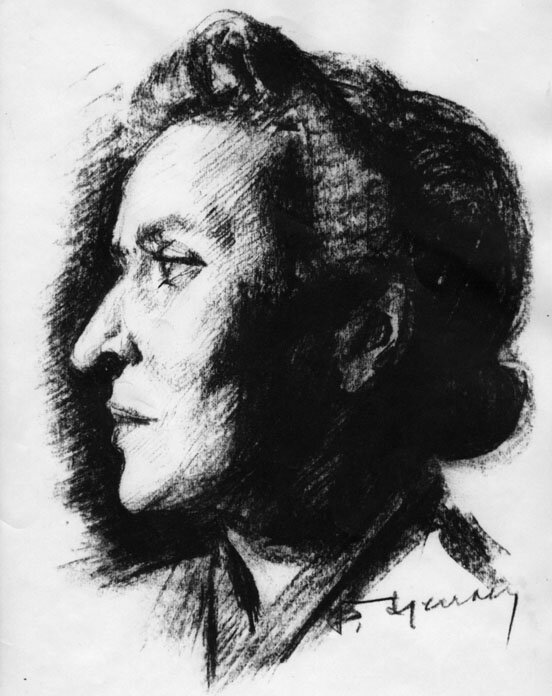
This is another drawing of the mother, Klara, one made during that period. Also undoubtedly in charcoal, this time some mid-tones were certainly lost, as under the nose. She was really a beautiful woman. I also drew her son, Pali, then, but those pictures, I think, ended up with his daughter, Zsuzsu, of whom there is much on the photography pages here.
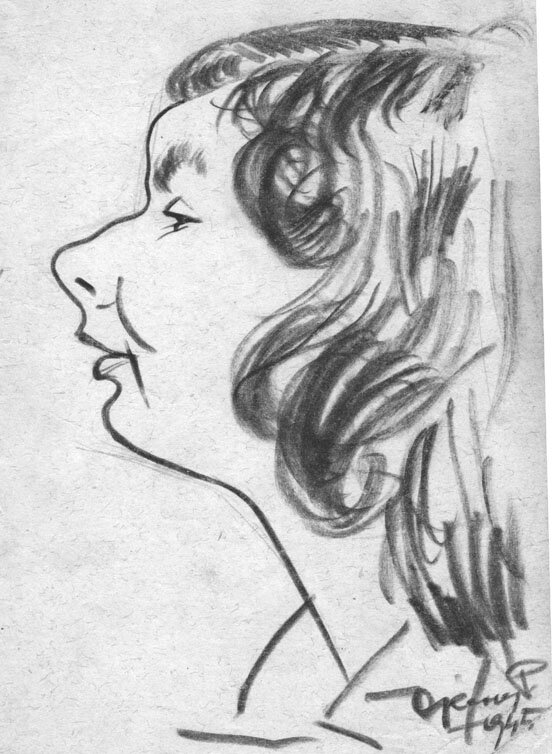
Another survivor from Gyöngyös was a cousin on my father's side, Edith, who also lost her entire family. She looked me up when I stayed in Budapest, and hence this caricature of her. She again found me in New York a couple of decades ago, and died about ten years ago. She was about six months older than I.
On having moved to Prague to see how I can manage my life independently, I did not spend much time on portraits. I actually can be said to have done many in the form of likenesses in the movie posters considered here in the commercial art section. The two pictures below are the only others I could dig up that may qualify.
10 July 2006
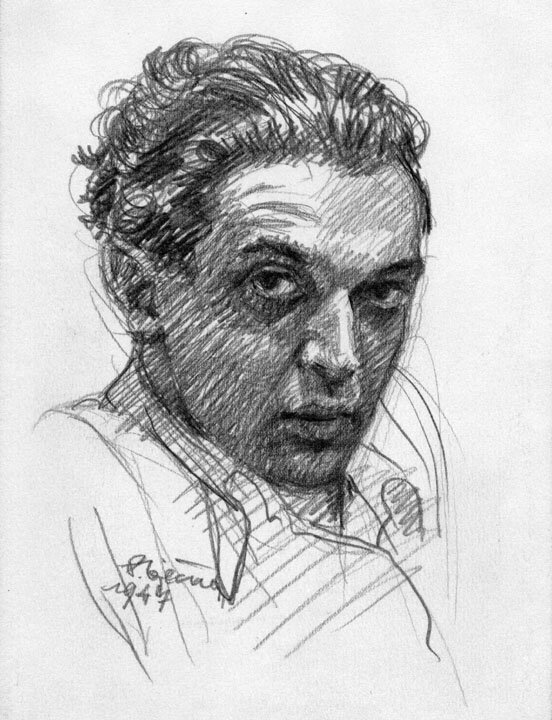
A self-portrait I always felt ambivalent about, maybe because a girl I knew didn't like it, saying it isn't me. I'll confess I tried to look too manly, while I was a very shy kid. But it may do here as a pencil portrait of that time.
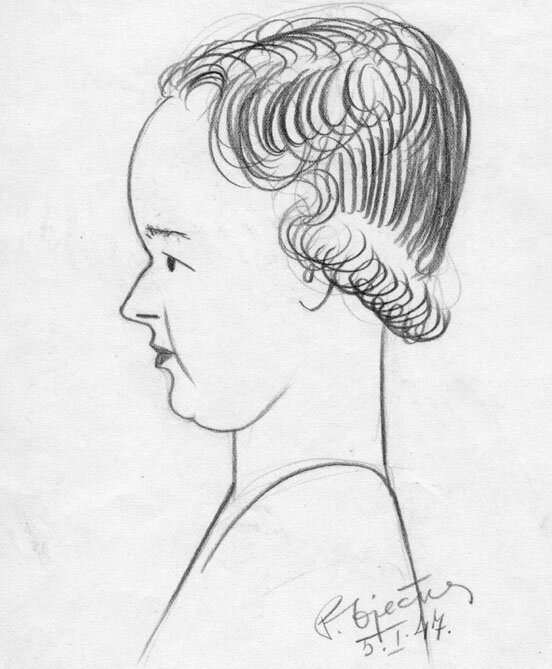
This is not an authentic portrait, but a remembrance of my mother in a stylized, caricature-like, form. But rather than a caricature, it is a related exaggeration of basic features, to bring out the innocent and gentle nature as something like an icon, like figures of saints on a gothic cathedral.